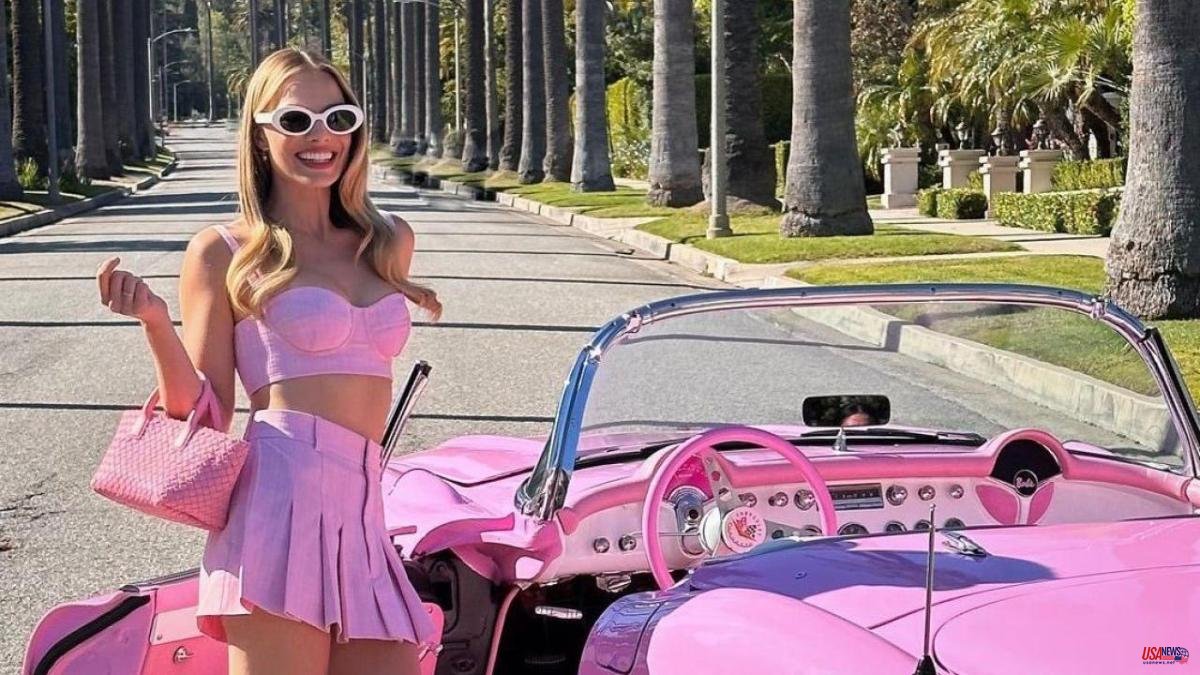A pink dress with white polka dots, the halter neck, by Valentino (recreation of a model from the spring/summer 1993 collection). A tweed jacket, the lattice of pink and white wool, from Chanel (the same one Claudia Schiffer wore to the spring/summer 1996 show). A taffy pink bustier and pleated miniskirt ensemble, signed by Bottega Veneta (the intricate Cabat bag in a matching mini version). A short pink metallic leather skirt with a pink knit crop top, turtleneck, and pink mesh minidress, all by Versace (archival pieces, fall/winter 1994). A fuchsia suit consisting of a jacket, top and miniskirt, embellished with crystals and accessorized with a heart-shaped bag and headband, from Moschino (spring/summer 2015 collection).
And so up to almost a dozen renditions to the fabulous wardrobe of the doll with the greatest popular reach of which there is news. More than commitment to her character, Margot Robbie on the Barbie promotional tour should be directly considered activism. From Los Angeles to Seoul, passing through Sydney, the Australian actress has given a lesson not only in fashion, but also in pop-à-porter culture during the two weeks of presentations of her film (it is directed by Greta Gerwig, but she, in addition to starring in it, produces it) to the international media.
A genuine tour de force for her head stylist, New Yorker Andrew Mukamal, the creator of a story that evokes the proverbial wardrobe of the plastic icon with real garments from a significant historical-commercial journey, proving that, in terms of clothing, Barbie is also a state of mind. "Playing with her is, basically, playing dress her up," concedes Jacqueline Durran, the film's Oscar-winning costume designer. And she concludes: "Clothes are her form of expression." Not just any clothes, of course.
Sexy labels aside, the point is that wearing Barbie means risking everything, or almost, on pink. Mattel, the multinational toy manufacturer that has produced Ruth Handler's creation since 1959, awarded magenta as a corporate tone; a chromatic strategy to attract the attention of the child consumer and that refers to femininity, love and innocence, but also impudence and even erotic provocation. No, pink is not a simple color, loaded with profound symbolism from its exotic origins, perhaps Indian or Chinese, associated with power. To begin with, because it was born without gender, to be used interchangeably by women and men, although for centuries it was preferred aristocratically masculine.
For contemporary fashion, it starts counting from 1936, when Elsa Schiaparelli baptizes a shade similar to Tire purple as shocking pink, the scandalous pink with sexual connotations on which she would base her style. In 1953, worn by Marilyn Monroe to sing "Diamonds are a girl's best friend" in the film Gentlemen Prefer Blondes, they renamed it hot pink.
Although the heat did not last long: that same year, Mamie Eisenhower appeared at the presidential ball with a pale pink creation by Nettie Rosenstein that was like throwing cold water on her. Wife of Dwight Ike Eisenhower, thirty-fourth president of the United States, the revered Mamie gave an institutional nature to the model of female conduct imposed after World War II, when men returned from the front lines and women had to retire to the rear of the home.
Since then, pink is not only the color of the first ladies, in every way, but also the conventional eternal feminine, infantilized and domesticated. “If she has to think, let her think pink!” exclaimed the fashion editor who wanted to transform the intellectual bookseller (played by Audrey Hepburn) into a haute couture model in A Face with an Angel (1957). Brigitte Bardot would shortly marry Jacques Charrier, corseted in that naive little pink Vichy checked midi dress designed by Jacques Esquerel that defused her as a sex bomb.
Pink equally dominated the wardrobe of The Supremes in the 1960s, white audiences not to be scared off. And when, in 1976, Charlie's Angels landed the cover of Time as a TV phenomenon (braless detective sorority in tomboy territory), they glammed it up in Nolan Miller's salmon-pink creations. Even Yves Saint Laurent dedicated a maximalist bow to her, worthy of any material girl of the neoliberal eighties.
Of course, made the law, made the trap. The new generations have known how to subvert such an impostor nature with radical twists in the political script, from the pussyhat that identified the female protests against Trump in 2017 to the imaginary queer. The current Barbiecore fever, with its unprejudiced reappropriation of the life in plastic is fantastic aesthetic, is still another symptom of the pink revenge. As Pierpaolo Piccioli, who has colored Valentino's upcoming autumn/winter season with his own Pantone, Pink PP, says it: “His is a form of freedom such as does not exist anywhere else in the realm of colour”.













